Power and Propulsion Systems
Created by Commodore Wilkan Targaryen on Sat Dec 21st, 2024 @ 1:18pm
Faster Than Light
Coaxial Warp Propulsion System
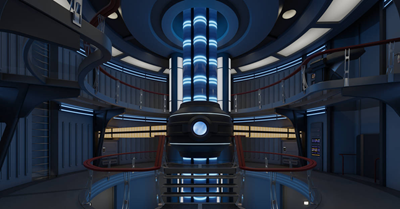 At the very heart of any starship is its Matter/Antimatter Reactor (M/AMR), more commonly known as its Warp Propulsion System or Warp Drive. This device allows interstellar travel to occur and works by annihilating antimatter with matter in a dilithium-controlled reaction, which is then channeled for power and to propel the ship on its journey. Each Warp Drive contains has three primary components: the Matter/Antimatter Reaction Assembly; the Power Transfer Conduits; and the Warp Nacelles.
At the very heart of any starship is its Matter/Antimatter Reactor (M/AMR), more commonly known as its Warp Propulsion System or Warp Drive. This device allows interstellar travel to occur and works by annihilating antimatter with matter in a dilithium-controlled reaction, which is then channeled for power and to propel the ship on its journey. Each Warp Drive contains has three primary components: the Matter/Antimatter Reaction Assembly; the Power Transfer Conduits; and the Warp Nacelles.Century Class vessels, such as the Enterprise, have been assigned to test Starfleet's new Coaxial Warp Drive. Built into the existing drive system, Coaxial Warp creates a warp field that “folds” space to allow the ship to travel immense distances quickly, far in excess of Warp Factor 9.9. Antineutrinos serve as a catalyst for the space-folding process, reconfiguring the internal geometry of the subatomic particles and creating a neutrino envelope to focus and amplify the space-folding process. Because Coaxial Warp Drive is still experimental and unproven, the system is prone to overload due to particle instabilities; however, a Polaric Modulator, similar in nature to a carburetor utilized in automobiles, is used to dilute the particle stream as it enters the core to compensate. Should this system become overwhelmed, personnel can use a symmetric warp field to stabilize the Coaxial Warp Drive or a chromoelectric field or pulse to disable the system. Should the crew fail to prevent the overload the drive will fail requiring extensive repairs. In some situations, the failure of the Coaxial Drive has led to a catastrophic detonation, destroying the ship, killing everyone aboard, and collapsing space within a billion kilometers around the detonation.
Matter/Antimatter Reaction Assembly
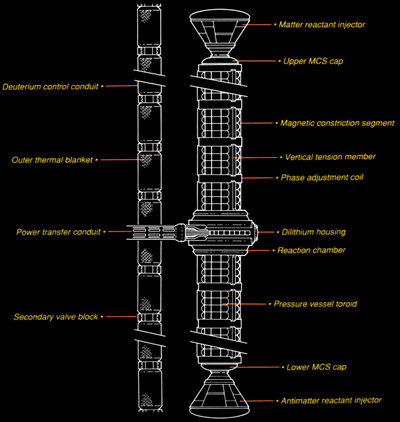 The Matter/Antimatter Reaction Assembly is the component of the Warp Drive where matter and antimatter are introduced to one another, generating power through the annihilation of the particles. The assembly contains three parts: the Reactant Injectors, the Magnetic Constriction Segments; and the Matter/Antimatter Reaction Chamber itself. These component parts are combined into a single Warp Core with the Matter Reactant Injector located at the top of the Core and the Antimatter Reactant Injector located at its base. The Matter Reactant Injector uses deuterium fuel and the Antimatter Reactant Injector uses an antimatter fuel to create the powerful reaction powering the vessel. Similar in design and function, the Antimatter Injector is specially modified with magnetic suspension fuel tunnels, preventing the antimatter from coming into contact with normal matter outside of the reactor. Construction advancements have permitted a six-lobed injector assembly design that allows for seven reactant streams to insert their fuels into the Magnetic Constriction Segments of the Warp Core, allowing the materials to be injected into the Matter/Antimatter Reaction Chamber.
The Matter/Antimatter Reaction Assembly is the component of the Warp Drive where matter and antimatter are introduced to one another, generating power through the annihilation of the particles. The assembly contains three parts: the Reactant Injectors, the Magnetic Constriction Segments; and the Matter/Antimatter Reaction Chamber itself. These component parts are combined into a single Warp Core with the Matter Reactant Injector located at the top of the Core and the Antimatter Reactant Injector located at its base. The Matter Reactant Injector uses deuterium fuel and the Antimatter Reactant Injector uses an antimatter fuel to create the powerful reaction powering the vessel. Similar in design and function, the Antimatter Injector is specially modified with magnetic suspension fuel tunnels, preventing the antimatter from coming into contact with normal matter outside of the reactor. Construction advancements have permitted a six-lobed injector assembly design that allows for seven reactant streams to insert their fuels into the Magnetic Constriction Segments of the Warp Core, allowing the materials to be injected into the Matter/Antimatter Reaction Chamber.The Matter/Antimatter Reaction Chamber channels the flow of the distinct fuels toward the dilithium crystals that manage the reactants. The only substance that does not react to antimatter when subjected to a high-frequency electromagnetic field, dilithium is stored within the Dilithium Articulation Frame within the Warp Core and allows the matter and antimatter to pass through the crystal’s structure without touching it. Computer controlled rotation allows for the manipulation of the manner in which the reactants meet within the Dilithium Articulation Frame, allowing for greater control and a "cleaner" power source. This allows the fuels to come into contact with each other, which are quickly annihilated in a reaction producing an enormous amount of energy quickly. Creating an intense plasma, this energy is directed to the Power Transfer Conduits immediately afterward.
Matter/Antimatter Fuel Storage
 Primary Matter Fuel Storage aboard the Starship Enterprise is provided by a colossal Deuterium Storage Tank within the vessel's Stardrive Section. Providing fuel to both the Impulse and Warp Propulsion Systems, the fuel tank is loaded with slush deuterium that is fed into the propulsion systems through reactant injectors. Normally the Deuterium Tank is loaded through supply lines located on the aft dorsal of the Stardrive Section and will last for approximately five years when fully loaded; however, internal equipment within the Warp Nacelles known as the Bussard Collectors will collect stray Hydrogen that can be used to create replacement Deuterium.
Primary Matter Fuel Storage aboard the Starship Enterprise is provided by a colossal Deuterium Storage Tank within the vessel's Stardrive Section. Providing fuel to both the Impulse and Warp Propulsion Systems, the fuel tank is loaded with slush deuterium that is fed into the propulsion systems through reactant injectors. Normally the Deuterium Tank is loaded through supply lines located on the aft dorsal of the Stardrive Section and will last for approximately five years when fully loaded; however, internal equipment within the Warp Nacelles known as the Bussard Collectors will collect stray Hydrogen that can be used to create replacement Deuterium.Located in the Stardrive Section, the Antimatter Storage Pods are magnetized self-contained storage units designed to contain the antimatter fuel used by the Enterprise during its Warp reaction. Consisting of multiple pods, the Antimatter Storage Assembly uses advanced containment fields to isolate the fuel within the pods from coming into contact with normal matter, preventing a catastrophic reaction. Loaded from transport vehicles during servicing at a Starbase, the Enterprise has been equipped with an antimatter generation system that can produce the fuel should the Enterprise be unable to return to base.
Power Transfer Conduits and Warp Nacelles
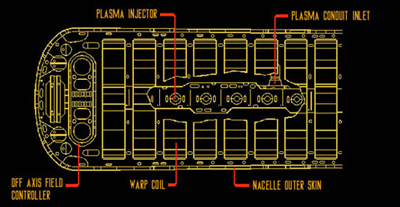
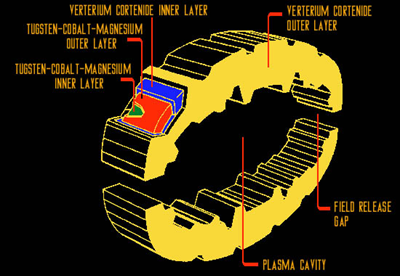
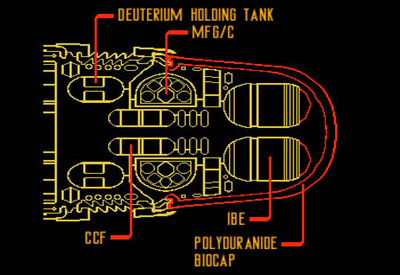 The Power Transfer Conduits split the plasma generated by the matter/antimatter reaction into an energy stream for the Warp Nacelles. Magnetic constriction is used to direct the energy stream toward the Warp Nacelles, with specialized Electroplasma System (EPS) taps allowing energy to be diverted to power the ship’s systems. The Power Transfer Conduits end within the Warp Nacelles themselves, which consist of three parts: the Plasma Injection System, the Warp Field Coils, and an Emergency Separation System.
The Power Transfer Conduits split the plasma generated by the matter/antimatter reaction into an energy stream for the Warp Nacelles. Magnetic constriction is used to direct the energy stream toward the Warp Nacelles, with specialized Electroplasma System (EPS) taps allowing energy to be diverted to power the ship’s systems. The Power Transfer Conduits end within the Warp Nacelles themselves, which consist of three parts: the Plasma Injection System, the Warp Field Coils, and an Emergency Separation System. Located within the Warp Nacelle, the Plasma Injectors divert plasma into the Warp Field Coils that allow for faster than light speeds to be achieved. The Century Class is fitted with 26 Primary Warp Field Coils and 48 Secondary Warp Field Coils in each nacelle that are made of tungsten-cobalt-magnesium and verterium cortenide. Nacelles use the energy generated by the Warp Core to shift the energy frequencies carried by the plasma deep into subspace, creating the Warp Field through the sequential firing of the Coils, causing the Warp Field layers to interact with one another. Currently, Starfleet employs Variable Geometry Warp Nacelles on all vessels, allowing the ship's engineers to generate a more energy-efficient subspace field with less waste as well as adjust its subspace field in highly turbulent spacetime. These advances in Warp technology allow the Enterprise to maintain stability at higher speeds for longer periods of time than most of her Starfleet cousins; however, these advancements have come at the cost of potentially causing microfractures within the hull at high speeds that could lead to catastrophic breach. To compensate for this, Starfleet has installed failsafe software into the nacelles that will cause the ship's Secondary Coils to disengage to automatically decrease speed unless overridden by both the Captain and Chief Engineer.
Located on the forward edge of the Warp Nacelle, the Bussard ramscoops are used to “sweep” interstellar space with a magnetic field. This field gathers hydrogen atoms in the event of a fuel shortage, allowing the ship to generate its own deuterium fuel. As needed other gases can also be collected by the ramscoop, or the crew can flush the ramscoops to eject the collected gases. This process also allows the crew to vent plasma from the Warp Nacelles in an emergency to prevent a catastrophic overload that would destroy the spacecraft. Should venting plasma not work, the Emergency Separation System can be engaged by the crew or automatically to eject a nacelle.
Quantum Slipstream Burst Propulsion System
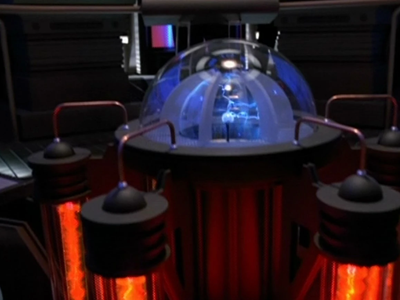 The Quantum Slipstream Burst Drive is an advanced propulsion system developed by Species 116 in the Delta Quadrant. Similar to the Transwarp Drive utilized by the Borg Collective, Slipstream allowed its user to exceed traditional warp factors by unprecedented speeds. While the Slipstream Drive is more energy-efficient than the Warp Drive, Slipstream requires more computer processing power than a Warp Drive due to the complex calculations needed to maintain the slipstream geometry. Despite the challenges, a smaller craft could enter and travel alongside the vessel generating a Slipstream Conduit without much risk.
The Quantum Slipstream Burst Drive is an advanced propulsion system developed by Species 116 in the Delta Quadrant. Similar to the Transwarp Drive utilized by the Borg Collective, Slipstream allowed its user to exceed traditional warp factors by unprecedented speeds. While the Slipstream Drive is more energy-efficient than the Warp Drive, Slipstream requires more computer processing power than a Warp Drive due to the complex calculations needed to maintain the slipstream geometry. Despite the challenges, a smaller craft could enter and travel alongside the vessel generating a Slipstream Conduit without much risk.Operating through a complex, precise reaction, generating a Slipstream Conduit begins by routing energy from the Quantum Drive in the Chevron Section to the Auxiliary Deflector Dish to emit high-energy tachyon bursts to alter the subspace field in front of the ship. This allows the vessel to penetrate the quantum barrier and create a Slipstream Conduit for travel. The process is, however, not without risk as the instabilities created by the Drive are a constant challenge for the vessel's crew and run the risk of overwhelming both structural integrity and the outer hull, especially as the vessel needed to project a Structural Integrity Field through the Navigational Deflector to compensate for gravimetric shear. Temporal stress was also a concern, requiring the need to fit the vessel with a Chroniton Integrator to project a chroniton field to maintain a temporal sync. In addition, the vessel could experience erratic power fluctuations during operation, increasing pressure on the Warp Propulsion System by flooding the system with tachyons and potentially triggering a Warp Core breach when operating in connected flight mode.
To successfully maintain the Slipstream Conduit, the vessel's Helm, Navigation, and Operations Officer continually monitor and adjust the phase variance of the quantum field to maintain the conduit's integrity, while Engineering would work to maintain the vessel's systems, specifically the Quantum Field Focus Controller that aided in maintaining systems in operational mode. Perhaps the most important component in the Slipstream Drive was the Multidimensional Wave-function Analysis module which allowed the starship to detect inter-dimensional rifts in subspace and temporal distortions that could risk deactivating the drive system. Should these processes fail the Slipstream Conduit would collapse and expel the ship back into normal space, often severely damaging if not destroying the vessel outright.
With a fully functional Quantum Slipstream Drive a starship could travel 300 light-years in less than an hour. Despite perfectly replicating the Drive from scans obtained by the USS Voyager, Starfleet has never been able to successfully replicate the Drive to the level of the original USS Dauntless nor acquire a sufficient supply of the rare mineral Benamite that regulates the Slipstream Drive. Instead, Starfleet has fielded the Quantum Slipstream Burst Drive using similar technology. The Burst Drive allows the user to open a Slipstream Conduit for 30 minutes before automatically shutting down, permitting travel of approximately 150 light-years. While a lighter version of the Slipstream Drive, the Burst Drive is not without risk and takes almost 12 hours to recharge after each use and near needs constant maintenance to remain operational.
Slower Than Light
Impulse Propulsion System
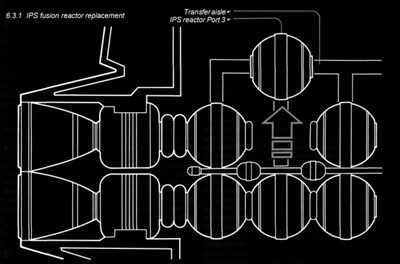 Used while traveling within a star’s gravity well, through solar systems, or in combat, Impulse Propulsion Systems are used by starships to move at sublight speeds. Currently, the Enterprise is fitted with three Impulse Engines in the Engineering Hull. Two Impulse Engines, hidden behind baffles to scatter their signature for stealth reasons, were located within the Chevron Section for use during separated flight mode.
Used while traveling within a star’s gravity well, through solar systems, or in combat, Impulse Propulsion Systems are used by starships to move at sublight speeds. Currently, the Enterprise is fitted with three Impulse Engines in the Engineering Hull. Two Impulse Engines, hidden behind baffles to scatter their signature for stealth reasons, were located within the Chevron Section for use during separated flight mode. The Impulse Drive of a Federation starship has not changed much in 200 years and has four main components: the Impulse Reaction Chamber (Fusion Reactor), the Accelerator/Generator, the Driver Coil Assembly, and the Vectored Exhaust Director. Each Impulse Drive contains three fusion reactors which generate thrust via a standard Newtonian reaction. Energy is released in the Impulse Reaction Chamber by a fusion reaction is then injected into the Accelerator/Generator, which speeds up the plasma and feeds it to the Driver Coil Assembly. Similar to the Warp Drive, Electroplasma System (EPS) taps run divert some energy to power other systems on the ship. The Driver Coils then create a field effect that passes its energy on to the Vectored Exhaust Director, which directs it to thrust the vehicle in the desired direction.
Each Impulse Engine consists of four linked Impulse Drives and is rated based upon the velocity it can provide. Regardless of an engine’s maximum sublight speed, Starfleet generally limits impulse travel to .25c to minimize risk the time-dilation problems which occur as a ship approaches the speed-of-light, but the Captain can override this directive. Further, operating at Maximum Impulse for longer than 24 hours risks damaging the engines. Each Impulse Engines also incorporates an Impulse Capacitance Cell capable of providing a temporary burst of power to the engine assembly by releasing the cells’ power directly into the driver coils to generate a burst of speed. While the Capacitance Cells are always available, they are more commonly utilized when exiting Fortress Mode to boost engine power to temporarily boost speed to make a hasty escape.
Reaction Control System
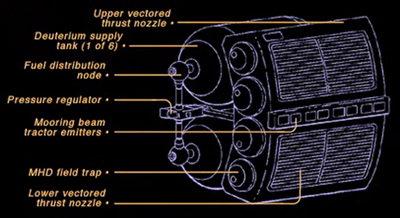 The Reaction Control System (RCS), also known as “thrusters,” are used for low-velocity propulsion, station-keeping, and maneuvering control in space.
The Reaction Control System (RCS), also known as “thrusters,” are used for low-velocity propulsion, station-keeping, and maneuvering control in space.Located at strategic points around the hull of the starship, the Primary RCS engines aboard the Enterprise are prototype Impulse Thrusters. Normally restricted to small craft, Impulse Thrusters are a special type of thruster capable of improving both the ship’s speed and maneuverability. Similar to the Impulse Engines that enable sublight travel, Impulse Thrusters contain a single fusion reactor to generate thrust into the Accelerator/Generator, which feeds the Driver Coil Assembly. The Driver Coils then create a field effect, passing the energy to the Vectored Exhaust Director to propel the vessel. Should the Enterprise's Impulse Engines fail it is possible for the Impulse Thrusters to propel the ship at sublight speeds, but cannot surpass .1c.
The Impulse Thrusters are supplemented by traditional RCS Thrusters powered by a gas-fusion reaction chamber. Utilizing deuterium fuel fed from the ship's deuterium tank, exhaust is delivered through a field trap into the vectored thrust nozzles that propel the ship. While the generated thrust is considerably lower, they effectively supplement the primary engines as needed.
Speed Chart
Warp Speed Distance Chart | |||||||
(400,000 km) |
(12 billion km) |
(5 ly) |
(20 ly) |
(8,000 ly) |
(2 million ly) | ||
| Full Thrusters | .00001 | 42.0 Hrs | 142.0 Yrs | 558,335.0 Yrs | 2,000,000.0 Yrs | 1.12 Billion Yrs | 223.33 Billion Yrs |
| Full Impulse | .25 | 5.38 Sec | 44.0 Hrs | 20.0 Yrs | 80.0 Yrs | 40,000.0 Yrs | 8,000,000 Yrs |
| Warp 1 |
1 | 1.3333 Sec | 11.1 Hrs | 5.0 Yrs | 20.0 Yrs | 8,000.0 Yrs | 2,000,000 Yrs |
| Warp 2 |
10 | 0.1323 Sec | 1.1 Hrs | 181.1 Days | 2.0 Yrs | 793.7 Yrs | 198,425.1 Yrs |
| Warp 3 |
39 | 0.0342 Sec | 17.1 Mins | 46.9 Days | 187.5 Days | 205.4 Yrs | 51,360.1 Yrs |
| Warp 4 |
102 | 0.0131 Sec | 6.6 Mins | 18.0 Days | 71.9 Days | 78.7 Yrs | 19,686.3 Yrs |
| Warp 5 |
214 | 0.0062 Sec | 3.1 Mins | 8.5 Days | 34.2 Days | 37.4 Yrs | 9,356.9 Yrs |
| Warp 6 |
392 | 0.0034 Sec | 1.7 Mins | 4.6 Days | 18.6 Days | 20.4 Yrs | 5,095.6 Yrs |
| Warp 7 |
656 | 0.0020 Sec | 1.0 Mins | 2.8 Days | 11.1 Days | 12.2 Yrs | 3,048.2 Yrs |
| Warp 8 |
1,024 | 0.0013 Sec | 39.1 Sec | 1.8 Days | 7.1 Days | 7.8 Yrs | 1,953.1 Yrs |
| Warp 9 |
1,516 | 0.0009 Sec | 26.4 Sec | 1.2 Days | 4.8 Days | 5.3 Yrs | 1,318.9 Yrs |
| Warp 9.2 |
1,649 | 0.0008 Sec | 24.3 Sec | 1.1 Days | 4.4 Days | 4.9 Yrs | 1,212.9 Yrs |
| Warp 9.6 |
1,909 | 0.0007 Sec | 21.0 Sec | 23.0 Hrs | 3.8 Days | 4.2 Yrs | 1,047.7 Yrs |
| Warp 9.9 |
3,053 | 0.0004 Sec | 13.1 Sec | 14.4 Hrs | 2.4 Days | 2.6 Yrs | 655.1 Yrs |
| Warp 9.99 |
7,912 | 0.0002 Sec | 5.1 Sec | 5.5 Hrs | 22.2 Hrs | 1.0 Yrs | 252.8 Yrs |
| Warp 9.9999 |
199,516 | 0.0000 Sec | 0.2 Sec | 13.2 Mins | 52.7 Mins | 14.6 Days | 10.0 Yrs |
| Coaxial 1 |
936657.7 | 0.0000 Sec | 0.0427 Sec | 2.9 Mins | 11.1 Mins | 3.2 Days | 2.3 Yrs |
| Coaxial 2 |
1710668 | 0.0000 Sec | 0.0234 Sec | 1.5 Mins | 6.0 Mins | 1.7 Days | 1.2 Yrs |
| Coaxial 3 |
2693338.3 | 0.0000 Sec | 0.0149 Sec | 58.6 Sec | 3.9 Mins | 1 Day | 271.1 Days |
| Coaxial 4 |
3404016.8 | 0.0000 Sec | 0.0118 Sec | 46.3 Sec | 3 Mins | 20.5 Hrs | 241.5 Days |
| Coaxial 5 |
4506388.9 | 0.0000 Sec | 0.0089 Sec | 35.0 Sec | 2.4 Mins | 15.5 Hrs | 162.1 Days |
| Warp 10 |
Infinite | ||||||
Power Generation
Primary Power
While Federation starships have multiple energy sources, Primary Power aboard the Enterprise is generated by the vessel's Propulsion Systems. The Coaxial Warp Core is the default source of energy while the Fusion Reactors of the Impulse Engines and the Quantum Slipstream Core supplement energy generation.
Electroplasma System (EPS)
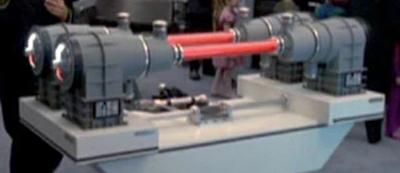 Energy generated by the ship's engines and other power sources is routed throughout the Enterprise by the vessel's Electroplasma System (EPS). Utilizing a network of Isomagnetic Conduits, EPS has been designed to efficiently transfer energy to all systems aboard the ship through its series of microwave power transmission waveguides. Depending upon the needs of the Enterprise, power can be transferred to increase the energy to a particular system, but this runs the risk that the EPS may not be able to handle these increased demands.
Energy generated by the ship's engines and other power sources is routed throughout the Enterprise by the vessel's Electroplasma System (EPS). Utilizing a network of Isomagnetic Conduits, EPS has been designed to efficiently transfer energy to all systems aboard the ship through its series of microwave power transmission waveguides. Depending upon the needs of the Enterprise, power can be transferred to increase the energy to a particular system, but this runs the risk that the EPS may not be able to handle these increased demands.
Auxiliary Power
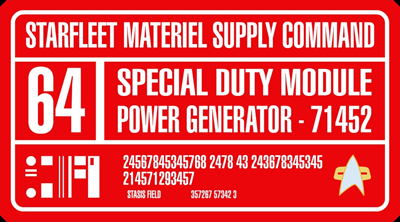 The Impulse Engines of the Enterprise are fitted with high-capacity Fusion Reactors to generate both power and thrust. In addition to these Fusion Reactors, Starfleet vessels are equipped with a secondary set of Fusion Reactors with the purpose of generating Auxiliary Power. Different from Emergency Power, Auxiliary Power Fusion Reactors can also be swapped with those of the Impulse Engines should those reactors become incapacitated.
The Impulse Engines of the Enterprise are fitted with high-capacity Fusion Reactors to generate both power and thrust. In addition to these Fusion Reactors, Starfleet vessels are equipped with a secondary set of Fusion Reactors with the purpose of generating Auxiliary Power. Different from Emergency Power, Auxiliary Power Fusion Reactors can also be swapped with those of the Impulse Engines should those reactors become incapacitated.
Emergency Power
Distinct from Auxiliary Power, Emergency Power is a small reserve of power that may be used in a crisis or when other power systems have been disabled. Like Auxiliary Power, the Emergency Power generators consist of a series of Fusion Reactors that are isolated from the Primary and Auxiliary Power systems. While helpful in an emergency, the Emergency Power Systems do not generate enough power to fulfill all power needs aboard the Enterprise and focus on crew support unless directed by the Commanding Officer.
Individual Power
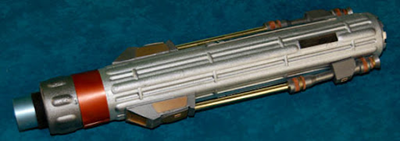 Some systems aboard the Enterprise, like the Bridge workstations and the Holodecks, are fitted with their own batteries that provide them with their own power. This energy reserve allows the crew to still utilize these systems when all other power systems aboard the ship have failed. It is possible for the crew to siphon this energy for other purposes in some emergency situations when all other power sources have failed, but the energy generated cannot power resource intensive systems for long.
Some systems aboard the Enterprise, like the Bridge workstations and the Holodecks, are fitted with their own batteries that provide them with their own power. This energy reserve allows the crew to still utilize these systems when all other power systems aboard the ship have failed. It is possible for the crew to siphon this energy for other purposes in some emergency situations when all other power sources have failed, but the energy generated cannot power resource intensive systems for long. Categories: Operations